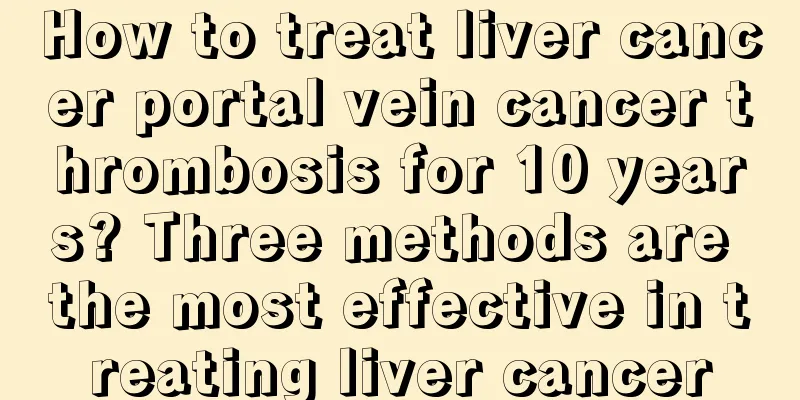How to treat liver cancer portal vein cancer thrombosis for 10 years? Three methods are the most effective in treating liver cancer

|
Liver cancer is the most common cancer in the world, with about 500,000 people dying from this disease every year. During the entire process of liver cancer formation and development, it is easy to form portal vein cancer thrombosis. So how to treat liver cancer portal vein cancer thrombosis for 10 years? 1. Surgical treatment Surgical resection is the first choice for patients with liver cancer combined with pVTTI and type II, and it may provide a chance of radical cure. Resection of the primary lesion and tumor thrombus can also reduce portal pressure, which can improve the patient's liver function and quality of life to a certain extent. Literature shows that surgical treatment is better than TACE6-7, especially pVTTI/II type is more suitable for surgical treatment than III/IV8. For patients with type I/II pVTT, pVTT and the affected portal vein can be removed together through liver lobe or hemihepatectomy; for type III patients, after resection of the primary lesion, the surgical methods of pVTT include portal vein end embolectomy through the liver section, portal vein reconstruction after resection of pVTT and affected portal vein, and portal vein end embolectomy and portal vein endarterectomy. There is no significant difference in the prognosis of these three surgical methods. At present, the most commonly used method is portal vein end embolectomy through the liver section. Special attention should be paid to preventing iatrogenic tumor spread during the operation. If the technology is feasible, measures such as blocking the portal vein trunk and the contralateral portal vein branches and opening the blood flow to flush the end after pVTT is removed should be taken. 2. Hepatic arterial infusion chemotherapy (TAI) or transcatheter chemoembolization (TACE) TAI is a common method for treating unresectable liver cancer with pVTT, but whether TACE can be used for patients with pVTT type III/IV is still controversial because it may cause liver failure. It is currently believed that as long as the liver function is still good and portal vein collateral circulation already exists in the portal area, TACE treatment can be considered. The efficacy of TACE in the treatment of pVTT varies greatly, with a complete remission rate (CR) of 0%, a partial remission rate (pR) of 19.5%-26.3%, and a stable rate (SD) of 42.5%-62.7%. The median survival of patients who responded to TACE was 13 months, and the median survival of patients who did not respond was 5 months; the median survival of patients with liver function Child-pugh A was 15 months, and that of Child-pugh B was only 5 months. Therefore, it is recommended that TACE be used in combination with other treatments. The commonly used embolic agents in China are iodized oil or gelatin sponge. Literature shows that the efficacy of embolic agents (TACE) is better than TAI or medical treatment alone. 9 The smaller the diameter of the embolic agent, the better the effect and the smaller the side effects for pVTT patients. Intraoperative superselection can improve the efficacy and reduce normal liver damage. In recent years, drug-loaded microsphere embolization for liver cancer has been gradually carried out in clinical practice, but its efficacy needs further verification. 3. Radiation therapy With the advancement of radiotherapy technology, the development of three-dimensional conformal radiotherapy (3DCRT), intensity modulated radiotherapy (IMRT) and stereotactic body radiation therapy (SBRT) can increase the target dose while protecting normal tissue to the maximum extent, and can be applied to patients with liver cancer and all types of pVTT. Target localization is recommended to use CT and MRI image fusion technology, or combine iodized oil deposition after TACE to determine the range of the gross tumor (GTV) of liver cancer. The clinical tumor volume (CTV) is GTV plus 5-10mm. The planned target volume (pTV) should be determined in combination with the internal target mobility, the positioning error of each center, and the random error. The scope of radiotherapy is still controversial, and the target area should be determined according to the situation. For primary lesions that are small and close to pVTT, radiotherapy should include the primary lesion and pVTT, and the total effective rate can reach 45.5%-50%. If the primary lesion is large or far away from pVTT, consider performing pVTT radiotherapy alone. |
>>: Why is liver cancer so common? These reasons are very common
Recommend
Fried ice cream recipe
Today's times are getting better and better. ...
What are the hazards of ascites caused by liver cancer
Patients with mid- to late-stage liver cancer oft...
Why does cutting peppers make your hands burn? It turns out this is the reason
When people cook daily, they often find that pepp...
What are the early symptoms of lung cancer? There are three early symptoms of lung cancer
Lung cancer is a serious malignant tumor that thr...
Red wine stains can be easily removed using this method
In daily life, if you accidentally get red wine s...
How to effectively treat testicular cancer
Testicular cancer is a tumor disease that occurs ...
Effective treatment of bone cancer Knowing the early symptoms is the key
Bone cancer patients not only have to endure the ...
The method of making garlic wine actually requires adding this?
Many people use ginseng and deer antler to make w...
Early symptoms and treatment of testicular cancer
Nowadays, due to environmental pollution, water p...
Prostate cancer radiotherapy price
Prostate cancer cells are androgen-dependent canc...
The effects and functions of celery porridge
People like to eat some light food in the morning...
What are the causes of lung cancer? The five major causes of lung cancer are better if you know them early
If you want to stay away from lung cancer, you sh...
Can I eat before doing a CT scan of my lungs?
Usually, CT scan is needed during physical examin...
Rehabilitation training for hemiplegia caused by cerebral hemorrhage, rehabilitation methods must be mastered
Cerebral hemorrhage is a very serious cerebrovasc...
How to deal with a husband with a bad temper
When a couple lives together, they need to unders...









